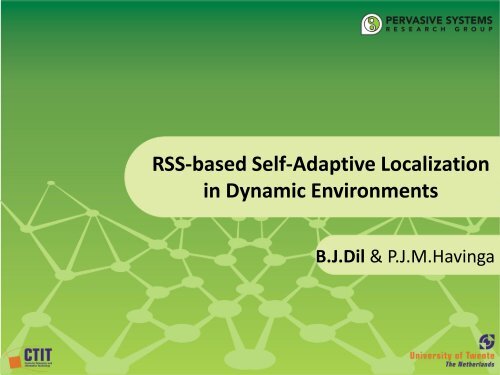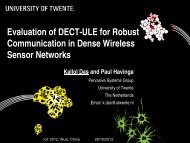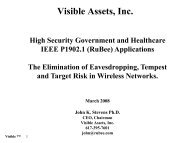RSS-based Self-Adaptive Localization in Dynamic Environments
RSS-based Self-Adaptive Localization in Dynamic Environments
RSS-based Self-Adaptive Localization in Dynamic Environments
- No tags were found...
You also want an ePaper? Increase the reach of your titles
YUMPU automatically turns print PDFs into web optimized ePapers that Google loves.
<strong>RSS</strong>-<strong>based</strong> <strong>Self</strong>-<strong>Adaptive</strong> <strong>Localization</strong><strong>in</strong> <strong>Dynamic</strong> <strong>Environments</strong>B.J.Dil & P.J.M.Hav<strong>in</strong>ga
MotivationSignal Strength Measurements• Availability• Complexity• Energy consumption2
MotivationHOWEVER• Highly dynamic• Highly depend<strong>in</strong>g on environment• Very unreliable3
MotivationSOLUTION• Calibrate propagation model (2.4 GHz)• Height transmitter/Receiver (6→30 cm, +17% decay)• Materials (height grass, +32% decay)• Antenna orientation (factor 32 difference)4
MotivationSOLUTION• Calibrate propagation model (2.4 GHz)• Height transmitter/Receiver (6→30 cm, +17% decay)• Materials (height grass, +32% decay)• Antenna orientation (factor 32 difference)Calibration determ<strong>in</strong>es scalability, applicability andperformance of localization algorithm.5
MotivationSOLUTION• Calibrate propagation model (2.4 GHz)• Height transmitter/Receiver (6→30 cm, +17% decay)• Materials (height grass, +32% decay)• Antenna orientation (factor 32 difference)• Mobile radio• Optimal calibration = orientation/place dependent• Calibrate propagation model each time the radio locatesitself6
Motivation8
GOALPlug-And-Play wireless localization system• Deploy and you are done• Multi-hop network• Automatic calibration9
Contents• Hardware• Propagation model• Antenna orientation• <strong>Self</strong>-<strong>Adaptive</strong> <strong>Localization</strong>• Results• <strong>Localization</strong> server10
Hardware• Chipcon 2.4 GHz modules– 4kb memory– 8051 Processor– IEEE 802.15.4 Radio– External Antenna• Costs– +/- 5 euro11
Propagation Model• Log-normal Shadow<strong>in</strong>g model– Scalair modelP• Unknowns are andd 0n12
Antenna Orientation• What happens?• Can we model this us<strong>in</strong>g a scalair model?13
Antenna Orientation14
Antenna Orientation15
Antenna OrientationErrorDistributionPlot16
<strong>Self</strong>-<strong>Adaptive</strong> <strong>Localization</strong>• Propagation model parameters are and• 3 <strong>Self</strong>-<strong>Adaptive</strong> <strong>Localization</strong> algorithmsTYPE Unknowns Calibrated P d0 Calibrated nLN-CON {x,y} Yes YesRR-SAL {x,y, P d0 } No YesPLE-SAL {x,y,n} Yes NoLN-SAL {x,y, P d0 ,n} No NoPd 0n17
<strong>Self</strong>-<strong>Adaptive</strong> <strong>Localization</strong>What happens if we do this?Pd 0n Pd0and are known and are unknownn18
<strong>Self</strong>-<strong>Adaptive</strong> <strong>Localization</strong>Put constra<strong>in</strong>ts on estimatorSo <strong>Self</strong>-<strong>Adaptive</strong> <strong>Localization</strong> is not possible under allcircumstances19
Results• Vertical antenna orientations– Unconstra<strong>in</strong>ed CON vs SAL– 1: Calibrated– 4: Unknown:P d,n021
Results• Vertical antenna orientations– Unconstra<strong>in</strong>ed CON vs SAL– Constra<strong>in</strong>ed CON vs SAL– 40% less error– 67% less std– 1: Calibrated– 4: Unknown:P d,n022
Results• Vertical antenna orientations– Unconstra<strong>in</strong>ed CON vs SAL– Constra<strong>in</strong>ed CON vs SAL– 40% less error– 67% less std– Measurementsvs Simulations– 1: Calibrated– 4: Unknown:P d,n023
Results• Unknown antenna orientation24
Results• Unknown antenna orientation– Unconstra<strong>in</strong>ed: SAL > CON– 1: Calibrated– 4: Unknown:P d,n025
Results• Unknown antenna orientation– Unconstra<strong>in</strong>ed: SAL > CON– CONSTRAINED:• 64% less error• 73% less std– 1: Calibrated– 4: Unknown:P d,n026
Localisation Server• <strong>Localization</strong> specific data is sent to server.• Can localize 10.000-100.000 nodes/seconds– Per processor27
ConclusionAutomatic calibration saves effort and money.• Plug-and-Play localization network.– Cover<strong>in</strong>g build<strong>in</strong>g of four floors.– Includ<strong>in</strong>g real-time PIR sensor data.– ~1 meter error <strong>in</strong>door.• Error reduced by ~50%• Reliability <strong>in</strong>creased by ~100%28






